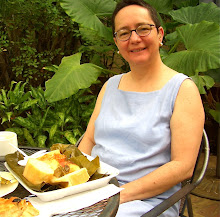
Zapatera is a shield volcano in Lago Colcibolca (Lake Nicaragua), about an hour by boat from Granada. Although its last eruption is unknown, there are lots of other types of excitement available for those who want to make the trip. The volcano forms what is known as La Isla Zapatera, the 2nd largest island in Lago Colcibolca, after Ometepe Island.
It is generally accepted that the island was inhabited by the Chorotegas, an indigenous tribe, one of the pre-columbian cultures of Mesoamerica. The earliest petroglyphs and ceramics date from various periods, some as old as 500 AD, while most dating between 800-1350 AD.

Right: "The Devil", anthropomophic statue, sitting human figure with an enormous head and big eyes, from Pensacola or La Marota, discovered by Ephraim George Squier, in 1849.
Today's post features a group of black basalt sculptures from Zapatera Island, which are today located in the San Francisco Convent Cultural Center in Granada (also known as part of the Casa de los Tres Mundos). They are known as the Squire Zapatera Collection, and are part of the permanent collection of the Cultural Center.
The first description of the Zapatera archaeological finds was by U.S. diplomat Ephraim George Squire. Between 1849 and the early 1850's he explored the area, and in 1852 published a monograph called "Nicaragua: its people and its landscapes. His drawings of the many various statues of different sizes and forms, of many petroglyphs were included in this monograph, which is now considered a classic volume on the archaeological history of Zapatera Island.

"Moctezuma", double statue of human figure with lizard or cayman on its head. From Zonzapote, Zapatera Island, discovered by Bovallius in 1883.
Decades later, inspired by Squire's work, Carl Bovallius, a Swedish naturalist began his own explorations, and discovered 25 statues in the area known as Sonzapote (in the northeastern part of the island), and petroglyphs in the La Ceiba islet. His discoveries were published in a work in 1886 in English on the archaeology of Nicaragua called "Nicaragua Antiquities", and a in large work in Swedish in 1887 called "Resa I Central America". The labels in the San Francisco Convent Cultural Center call him: "A pro-American and a humanist with a great personality, he is no doublt on e the the most outstanding [Swedes] who traveled through Latin American at the end of the last century."

Right: Double statue, sitting masculine human figure holding an anthropomorphic figure on its head, discovered by Joaquin Gomez.
Later, a third report by Mexican scholar Felipe Pardines was published through various articles at the end of the 1930’s. He reported petroglyphs on the El Muerte Island, and he made different drawings than the ones published by Squier and Bovallius. More recently a book written by Jorge Eduardo Arellano was published, called "The Squier-Zapatera Collection: Study of Pre-Hispanic Statues".
The photo at the opening of this post shows the magnificent hall of Zapatera statues at the San Francisco Convent Cultural Center in Granada. These 28 statues, carved of black basalt, measure between 3 feet to 6 feet in height, and give the impression of brooding and monumental spirits. The most representative form of these sculptures is that of a human being associated with an animal. The association of a human with an animal is traditionally interpreted as an individual and its alter ego or "other self". In some cases, the animal may represent the human's protector or its "particular totem". This interpretation is commonly accepted in the descriptions of Middle and South American statuary.

Left: "The Lizard", double statue, sitting human masculine figure, with head of lizard on top of it. From Zonzapote, Zapatera Island, discovered by Bovallius, 1883.
It is speculated that these statues represent gods or social leaders like Indian chiefs, warriors, or priests. A large part of them was found surrounded by a small hillock of soil and stones, with the back of the statue facing the center. It is therefore assumed that these sites were once ceremonial centers or sanctuaries, where sacrifices were possibly made. Regardless of the specific use and interpretation, the Zapatera Island sites represent a phenomenal national archaeological treasure, and point to Zapatera Island as the center of a significant indigenous Meso-American culture and spiritual tradition spanning hundreds of years. While Zapatera Island is now protected as a national park, the mysterious past exhibited in the findings on Zapatera Island are worthy of more much more study and investigation, and should be protected as part of Nicaragua's national heritage.
Because these mysterious stone titans form such a central part of Nicaragua's heritage, it was inevitable that the country's most famous literary figure, the poet Ruben Dario, who died in 1916, would have reflected on them. ''The great idols have the air of oriental stone gods,'' Dario wrote. ''They represent supernatural beings, coarsely sculpted in obscure basalt monoliths by the hands of fetishists.''

 Lionel Barrios, the husband of Daysis Sanchez, joined the Sanchez family studio and produces beautiful vessels including many functional art pieces.
Lionel Barrios, the husband of Daysis Sanchez, joined the Sanchez family studio and produces beautiful vessels including many functional art pieces. His etched work on a black background results in truly delightful works of art (see below).
His etched work on a black background results in truly delightful works of art (see below).











































